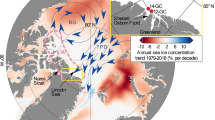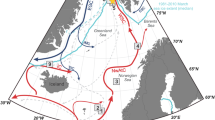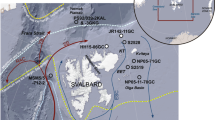Abstract
The question of the distribution of winter and summer sea-ice cover during the last glacial maximum (18,000 yr BP) is important in climatic modelling of the glacial world. We have now compared satellite-derived 5-yr monthly averages of per cent summer sea-ice cover in the Atlantic and Pacific sectors of the Southern Ocean with the distribution of reported sedimentological indicators of sea-ice cover at the sediment–water interface. These data strongly suggest that sediment type cannot be used to identify summer sea-ice limits, neither in Recent sediments nor in sediments of the last glacial maximum. Rather, the data seem to indicate that sediment type can be used to identify spring sea-ice limits for these two time intervals.
This is a preview of subscription content, access via your institution
Access options
Subscribe to this journal
Receive 51 print issues and online access
$199.00 per year
only $3.90 per issue
Buy this article
- Purchase on Springer Link
- Instant access to full article PDF
Prices may be subject to local taxes which are calculated during checkout
Similar content being viewed by others
References
Philippi, E. Deutsche Sudpolar-Expedition, 1901–1903 Vol. 2, 415 (1912).
Schott, W. Recent mar. Sediments Vol. ? 396 (1939).
Hough, J. L. J. Sedim. Petrol. 26, 301 (1956).
Lisitzin, A. P. Deep Sea Res. 7, 88 (1960).
Goodell, H. G. Antarctic Map Folio Ser. No. 17 (1973).
Lozano, J. A. & Hays, J. D. Investigation of Late Quaternary Paleoceanography and Paleoclimatology, 303 (Geological Society of America, Washington, DC, 1976).
Hays, J. D. et al. Investigation of Late Quaternary Paleoceanography and Paleoclimatology, 337 (Geological Society of America, Washington DC, 1976).
Cooke, D. W. & Hays, J. D. Proc. 3rd Symp. Ant. Geol. Geophys. (in the press).
Cooke, D. W. thesis, Columbia Univ. (1978).
Kukla, G. & Gavin, J. Science 214, 497 (1981).
Heap, J. A. in Antarctica, 187 (Praeger, London, 1965).
Kukla, G. J. Climatic Change, 114 (Cambridge University Press, 1978).
Hart, T. J. Discovery Rep. 21, 261 (1942).
Burckle, L. H. & Clarke, D. B. Nova Hedwegia 54, 1977 (1977).
Hogan, A. S., Barnard, S. & Somson, J. Geophysical Monitoring for Climatic Change, No. 7, 89 (NOAA Environmental Research Laboratories, 1978).
Mosley-Thompson, E. Inst. pol. Stud. Rep. (1980).
Murozumi, M., Chow, T. & Patterson, C. Geochim. cosmochim. Acta 33, 1247 (1969).
Author information
Authors and Affiliations
Rights and permissions
About this article
Cite this article
Burckle, L., Robinson, D. & Cooke, D. Reappraisal of sea-ice distribution in Atlantic and Pacific sectors of the Southern Ocean at 18,000 yr BP. Nature 299, 435–437 (1982). https://doi.org/10.1038/299435a0
Received:
Accepted:
Issue Date:
DOI: https://doi.org/10.1038/299435a0
This article is cited by
-
High-resolution climate simulation of the last glacial maximum
Climate Dynamics (2008)
-
Late Pleistocene variations in Antarctic sea ice I: effect of orbital insolation changes
Climate Dynamics (1988)
-
Late Pleistocene variations in Antarctic sea ice II: effect of interhemispheric deep-ocean heat exchange
Climate Dynamics (1988)
-
Ice diatom floras, Arthur Harbor, Antarctica
Polar Biology (1987)
Comments
By submitting a comment you agree to abide by our Terms and Community Guidelines. If you find something abusive or that does not comply with our terms or guidelines please flag it as inappropriate.



